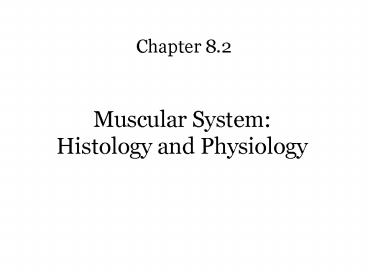Muscular System: Histology and Physiology PowerPoint PPT Presentation
Title: Muscular System: Histology and Physiology
1
Muscular SystemHistology and Physiology
- Chapter 8.2
2
Sliding Filament Model of Contraction
- -
- In the relaxed state, thin and thick filaments
overlap only slightly - Upon stimulation, myosin heads bind to actin and
sliding begins
3
Sliding Filament Model of Contraction
- Each myosin head binds and detaches several times
during contraction, acting like a ratchet to
generate tension and propel the thin filaments to
the center of the sarcomere - -
4
Neuromuscular Junction
- Region where the motor neuron stimulates the
muscle fiber - The neuromuscular junction is formed by
- 1. End of motor neuron axon (axon terminal)
- Terminals have small membranous sacs (synaptic
vesicles) that contain the neurotransmitter
acetylcholine (ACh) - 2. The motor end plate of a muscle
- A specific part of the sarcolemma that contains
ACh receptors - Though exceedingly close, axonal ends and muscle
fibers are always separated by a space called the
synaptic cleft
5
Neuromuscular Junction
Figure 9.7 (a-c)
6
Motor Unit The Nerve-Muscle Functional Unit
- A motor unit is a motor neuron and all the muscle
fibers it supplies - The number of muscle fibers per motor unit can
vary from a few (4-6) to hundreds (1200-1500) - Muscles that control fine movements (fingers,
eyes) have small motor units - -
7
Motor Unit The Nerve-Muscle Functional Unit
Figure 9.12 (a)
8
Motor Unit The Nerve-Muscle Functional Unit
- Muscle fibers from a motor unit are spread
throughout the muscle - Not confined to one fascicle
- Therefore, contraction of a single motor unit
causes weak contraction of the entire muscle - -
9
Smooth Muscle
- Cells are not striated
- Fibers smaller than those in skeletal muscle
- Spindle-shaped single, central nucleus
- More actin than myosin
- No sarcomeres
- Not arranged as symmetrically as in skeletal
muscle, thus NO striations. - Caveolae indentations in sarcolemma
- May act like T tubules
- Dense bodies instead of Z disks
- Have noncontractile intermediate filaments
10
Smooth Muscle
- Grouped into sheets in walls of hollow organs
- Longitudinal layer muscle fibers run parallel
to organs long axis - Circular layer muscle fibers run around
circumference of the organ - Both layers participate in peristalsis
Figure 9.24
11
Smooth Muscle
- Is innervated by autonomic nervous system (ANS)
- Visceral or unitary smooth muscle
- -
- -
- -
- -
- Multiunit
- Cells or groups of cells act as independent units
- Arrector pili of skin and iris of eye
12
Cardiac Muscle
- Found only in heart where it forms a thick layer
called the myocardium - Striated fibers that branch
- Each cell usually has one centrally-located
nucleus - Fibers joined by intercalated disks
- IDs are composites of desmosomes and gap
junctions - Allow excitation in one fiber to spread quickly
to adjoining fibers - Under control of the ANS (involuntary) and
endocrine system (hormones) - Some cells are autorhythmic
- -
13
Cardiac Muscle Tissue
Figure 10.10a
14
Disorders of Muscle Tissue
- Muscle tissues experience few disorders
- -
- Skeletal muscle remarkably resistant to
infection - Smooth muscle problems stem from external
irritants
15
Disorders of Muscle Tissue
- Muscular dystrophy a group of inherited muscle
destroying disease - Affected muscles enlarge with fat and connective
tissue - Muscles degenerate
- Types of muscular dystrophy
- -
- -
16
Disorders of Muscle Tissue
- Myofascial pain syndrome pain is caused by
tightened bands of muscle fibers - Fibromyalgia a mysterious chronic-pain syndrome
- Affects mostly women
- Symptoms fatigue, sleep abnormalities, severe
musculoskeletal pain, and headache
17
Developmental Aspects Regeneration
- Cardiac and skeletal muscle become amitotic, but
can lengthen and thicken - Myoblast-like satellite cells show very limited
regenerative ability - Cardiac cells lack satellite cells
- Smooth muscle has good regenerative ability
- There is a biological basis for greater strength
in men than in women - Womens skeletal muscle makes up 36 of their
body mass - Mens skeletal muscle makes up 42 of their body
mass
18
Developmental Aspects Male and Female
- These differences are due primarily to the male
sex hormone testosterone - With more muscle mass, men are generally stronger
than women - Body strength per unit muscle mass, however, is
the same in both sexes
19
Developmental Aspects Age Related
- With age, connective tissue increases and muscle
fibers decrease - Muscles become stringier and more sinewy
- By age 80, 50 of muscle mass is lost
(sarcopenia) - Decreased density of capillaries in muscle
- Reduced stamina
- Increased recovery time
- Regular exercise reverses sarcopenia

